Body water/hydration levels
General health standards indicate that one should consume approximately
64 oz of water per day from food and liquids to maintain a healthy level of hydration.
Maintaining a good hydration level will help improve your overall health and general
feeling of well-being. If your hydration levels are lower than average, you should
increase your water intake accordingly.
Body water/hydration level – how is it measured?
The hydration level is measured by using Bioelectric Impedance Analysis (BIA).
The same analysis that is used to calculate your body fat is used to calculate your
hydration level. Taking into consideration a user’s age and gender, a calculation is
made that determines the percentage of water.
Please note: It is not recommended to take the hydration measurements in certain
situations, such as following exercise, after drinking a glass of water, or directly prior
to, during or shortly after menstrual cycles. Hydration may not be at normal levels
during these times.
Bone mass – what is it?
Bone is a living, growing tissue. During youth, your body makes new bone tissue
faster than it breaks down older bone. In young adulthood, bone mass is at its peak;
after that, bone loss starts to outpace bone growth, and bone mass decreases.
But it’s a long and very slow process that can be slowed down even more through
calcium-rich diets and weight-bearing exercise.
Who should monitor bone mass?
Most people have no need to monitor bone mass, but certain groups – post-
menopausal women, men and women with certain diseases, and anyone who takes
medications that affect bone tissue – might want to watch for decreases in bone
mass. The bone mass reading is to be used as guide only. Watch for trends over time
and contact your healthcare provider for a more detailed explanation of the readings
and with any questions or concerns.
Weight and Body Fat
How does it work?
While body fat can be measured in many ways, the method used in your scale
is bioelectrical impedance. This indirect method of determining body fat starts when
a safe and very low electrical current is sent through the lower half of the body.
The electrical current flows more quickly through water and muscle than it will
through bone and fat. The scale measures the speed of the current. Based on this
number, the scale estimates body fat using a multi-step, mathematical formula.
Is it accurate?
Measurements of body fat tend to fluctuate a lot more than simple weighing,
and different methods of estimating body fat yield very different results. Just as
different scales give different results, different body fat analyzers can provide
very different body fat estimates. Even with the same scale the numbers will
vary because:
• Weight loss tends to produce substantial, continuous, and unpredictable changes
in body water content. Because body fat analysis is determined by water content
in the body, results can vary considerably from day to day.
• Hydration status affects body fat results. If you’ve just worked out, there is less
water for the electrical current to flow through. This may result in a higher body
fat result. In the same way, if you measure your body fat after drinking a lot of
fluid, it may appear that body fat is lower than it really is.
• Skin temperature can have an influence also. Measuring body fat in warm humid
weather when skin is moist will yield a different result than if skin is cold and dry.
• As with weight, when your goal is to change body composition it is better to track
trends over time than to use individual daily results.
• Results may not be accurate for persons under the age of 16, or persons with
an elevated body temperature, diabetes or other health conditions.
What you need to know!
• Percent body fat refers to the number of pounds of fat divided by your total body
weight and multiplied by 100.
• During weight loss, percent body fat doesn’t appear to be reduced as quickly
as expected because total weight loss and total body fat are decreasing at the
same time (for a more detailed explanation, see next section).
• Weight loss in the form of body fat and lean tissue (muscle) is common, and
is normal.
• To minimize the loss of lean tissue, include regular physical activity, especially
strength training, in your weight-loss plan.
Why do I lose weight but my body fat percentage doesn’t change much?
Most body fat monitors show body fat as a percentage only. This body fat
monitor shows you not only a percentage but the actual number of body fat
pounds (in fact, this is the measurement you see after your weight is displayed).
Why is that important? When you lose weight, both the numerator (pounds of
body fat) and denominator (total body weight) go down, so when it’s calculated as
a body fat percentage, the number can be small. For example, a person may weigh
200 pounds and have 40% body fat (= 80 pounds of body fat). He/She loses
20 pounds, but the body fat has only dropped 4% to 36%. That 4% of body fat was
16 pounds of fat – a very significant amount! So do not be overly concerned if you
do not see the percentage change quickly as you are losing weight: monitor the
absolute number of body fat pounds lost. Remember, to minimize the loss of
lean tissue, include regular physical activity, especially strength training, in your
weight-loss plan.
Body Analysis Table
Always keep in mind that you know your body best. The following ranges of
body fat, BMI, body water and bone mass are offered as guides.
Make the most of it!
To summarize, make the most of the body analysis feature by:
• Tracking change over time and not day to day.
• Using the same scale as much as possible.
• Being extra-consistent in the time of day, day of the week, time before or after
food and fluid consumption, before or after exercise, etc., when measuring
body composition.
While a scale/body fat monitor can be a useful tool on your weight-loss
journey, it’s not in and of itself a program for losing weight. Studies show
that people lose three times more weight on Weight Watchers than they do
on their own.*
Come to a meeting and learn from us the best way to lose and maintain
weight. Call 1-800-651-6000 or go to WeightWatchers.com to find a
meeting near you.
Important Information Concerning
Weight Management
Your scale is the best tool for monitoring weight. While not the only measure
of weight loss, scales are the most popular method used to gauge weight-loss
success. A scale measures the sum of your total body weight, which includes
bone, muscle, fat, and water.
Body weight fluctuates during the day, and from day to day,
depending on a variety of factors.
• Salt and carbohydrate intake can affect the body’s water retention.
• A large meal adds weight and can cause water retention.
• Dehydration from exercise, illness, or low fluid intake can result in weight loss.
• Muscle is also a factor. Heavy-duty resistance training can build muscle, which
can affect weight.
• The menstrual cycle can cause temporary weight gains and losses.
When You’re Losing Weight
It’s important not to put too much stock in the exact number on the scale,
because it can and will vary. This is especially true when you’re dieting. Small weight
gains and losses are common as your body adjusts to fewer calories and more
exercise. Your scale is a valuable tool when used to track weight over a
period of weeks and months. Be aware that different scales often give different
results. The scale at your doctor’s office may show one weight, and your scale at
home another. So don’t get too caught up with a single number.
*Heshka S et al. Weight loss with self-help compared to a structured commercial program: a randomized controlled trial.
JAMA 2003; 289(14): 1792-1798.
Don’t Overdo It!
A surefire way to get overly concerned with your weight is to weigh yourself too
often. We generally recommend weighing yourself no more than once a week when
you’re dieting. Though it’s hard to stick to this pattern, it’s the best way to prevent
unnecessary concern with normal weight fluctuations, which are unrelated to your
weight-loss efforts. Regardless of your weighing habits, it’s important that you’re
consistent.
Here are 5 rules for effectively monitoring your weight – weigh yourself:
To keep track of your weight, record only one number for the week.
This will give you a clear picture of any trend your weight is following.
When You’re Maintaining Weight
Fluctuations in day-to-day weight tend to be smaller when weight is stable,
so a more frequent weigh-in pattern is helpful. To maintain a stable weight:
• Weigh yourself more often than once a week.
• Use the “5-pound rule” – research shows that people who keep weight
within a 5-pound range are more likely to maintain a healthy body weight
over the long term.
Facts You Should Know
Your Weight Watchers scale is a precise measuring instrument that is most
accurate when weighing a stationary object. To ensure accurate readings,
always try to stand on the same area of the scale platform and DO NOT MOVE.
Should the weight on the scale exceed the scale’s capacity, you may see an error
message ”ERR”.
Electronic sensors are sensitive. Be careful not to drop or jar the scale.
Place it gently onto floor surface, and store where it will be protected from impact.
The scale is an electronic instrument and should never be submerged in water.
Clean with damp cloth and/or glass cleaner.
In the event that the scale battery needs to be replaced, open the battery cover on
the bottom of the scale and replace the old battery with a new 3V lithium battery
(CR2032). Dispose of the old battery properly. Do not attempt to open the
scale or to remove any components. Servicing should be done by qualified
technicians only. See warranty information below.
• Once a week, on the same day of
the week
• At the same time of day
• In the same place
• Wearing the same clothes
• Using the same scale
low on target high
BMI <20 20-25 25+
Body Fat
age % % %
Male 20-29 <13% 13.1-23% 23.1%+
30-39 <14 14.1-24 24.1+
40-49 <15 15.1-25 25.1+
50-59 <16 16.1-26 26.1+
60-69 <17 17.1-27 27.1+
Female 20-29 <18 18.1-28 28.1+
30-39 <19 19.1-29 29.1+
40-49 <20 20.1-30 30.1+
50-59 <21 21.1-31 31.1+
60-69 <22 22.1-32 32.1+
Body Water
age % % %
Male 20-69 <50% 50-65% 65%+
Female 20-69 <45 45-60 60+
Bone Mass
age % % %
Male 20-29 <7.6% 7.6-8.4% 8.5%+
30-39 <7.4 7.4-8.2 8.3+
40-49 <7.0 7-7.8 7.9+
50-59 <6.6 6.6-7.4 7.5+
60-69 <6.3 6.3-7.1 7.2+
Female 20-29 <6.2% 6.2-7% 7.1%+
30-39 <6.0 6-6.8 6.9+
40-49 <5.6 5.6-6.4 6.5+
50-59 <5.2 5.2-6 6.1+
60-69 <4.9 4.9-5.7 5.8+

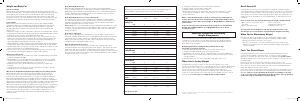



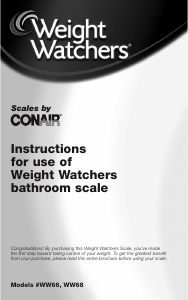
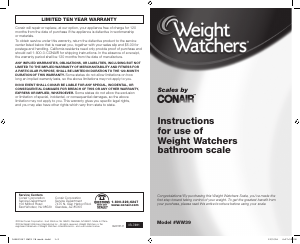
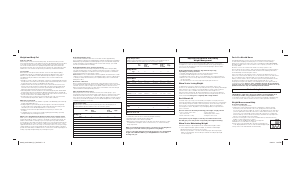


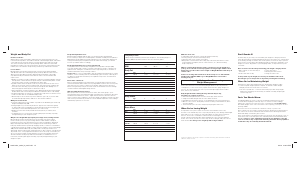
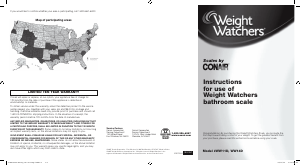
Praat mee over dit product
Laat hier weten wat jij vindt van de Conair WW67T Weight Watchers Weegschaal. Als je een vraag hebt, lees dan eerst zorgvuldig de handleiding door. Een handleiding aanvragen kan via ons contactformulier.